How to B2B Websites: Successful Corporate Websites Made Easy
We explain to you everything you need to know about B2B websites and how you can get started with them.

What exactly is a B2B website, and what makes it successful? In this article, our guest author Sara Bak shows you everything you need to know about the topic and which elements make a good B2B website.
B2B vs. B2C vs. D2C website - What's the difference?
The terms B2B, B2C and D2C are often bandied about in connection with websites. But what do they actually mean?
B2B stands for "Business-to-Business" and refers to business relationships between companies. In the context of websites, B2B means that the website is designed to sell products or services to other companies or to collaborate with them.
A B2B website can, for example, be a platform where companies sell their products to other companies. However, B2B products & services are often very explanatory, which is why websites can provide a lot of clarification or motivate contact.
Therefore, B2B websites rarely have a shop system. Their focus is more on branding and generating leads, inquiries, demos or sign-ups.
In contrast stands B2C, "Business-to-Consumer", which describes a business model in which a company has direct contact with end consumers. So, a B2C website would be more targeted at individuals who want to buy products or use services. This is by far the most common form of websites and in most cases has a shop system through which the products are directly distributed.
D2C, i.e., "Direct-to-Consumer" is a sub-form of B2C: It refers to websites where companies sell their products or services directly to end consumers, without going through traditional distribution channels such as retailers or distributors.
D2C websites are particularly attractive for e-commerce companies, as they offer a cost-effective way to establish their products or services in the market and build their customer base.
A special feature of D2C and B2C websites is that the customer journey is usually much shorter than that of B2B customers. The reason for this is that purchasing decisions in the D2C and B2C sectors are made by individual consumers, who are more influenced by emotional factors.
If a product or service meets their needs, impulse purchases often occur, which are made within a very short time. This is especially the case with low-cost products.
The customer journey on B2B websites
In the B2B sector, it is often about complex products or services that are sold to companies. The purchasing decisions are not made by one person, but by groups of decision-makers within the company, who are often influenced by rational factors such as price, quality and benefit. Typical roles that belong to the decision-making group could be:
- User
- Decision maker
- Recommender
- Influencer and
- Signer
All these roles have different questions during the decision-making processes and need a variety of different information. This requires a different approach than in the B2C customer journey, which only one user goes through.
In addition, these decisions may require more time and resources, as they often need to be coordinated by many departments or people within the company. Therefore, the customer journey or the sales cycle usually takes longer and extends over weeks or months.
Another important point where a B2B customer journey differs from the one in the B2C or D2C sector is the goal: Here, in most cases, it's not about a sale but a long-term business relationship. That's why the customer journey with its touchpoints looks different:
- Awareness: The company recognizes a problem that needs to be solved. In the search for the solution, the company becomes aware of the B2B company's offer, among other things.
- Consideration: Based on research, the company comes into the narrower selection for a collaboration. Usually, initial contact is made here to discuss open questions and clarify whether a collaboration makes sense for both parties.
- Transaction: It emerges from the initial contact that all requirements and demands on the company are met. The purchase/transaction/collaboration takes place.
- Experience: This phase is crucial for the course of the business relationship: based on the experience that the company has with the product or service, it decides to continue or terminate the collaboration. Ideally, not only can the company's expectations be met here, but they can also be exceeded, making a future business relationship more likely.
- Loyalty: The last phase of the B2B customer journey is also the most important: to achieve the goal of a long-term business relationship, a solid foundation must be created here. If this succeeds, a cycle is created in which new purchases/transactions/collaborations occur again and again.
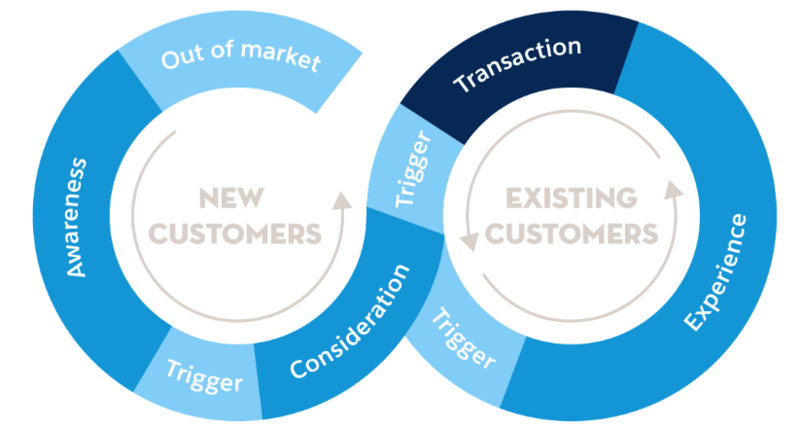
Source: salesforce
To achieve that this Customer Journey actually becomes a cycle, it is important to provide the right information at the right time. To improve this process and the overall customer journey systematically, it is advisable to develop a Customer Journey Map. It is also advisable to learn more about the various roles in the decision-making process and their needs.
ICP vs. Persona – Decisions are not made by one person
Unlike in B2C, in B2B more than one person is usually involved in the purchasing decision. While personas are often developed in B2C marketing, ICPs are more relevant in B2B. ICP stands for “Ideal Customer Profile” and describes companies that fit perfectly into the target group due to specific characteristics. These ICPs can in turn contain various buyer personas. The most important of these are: User, Decision Maker and Blocker.
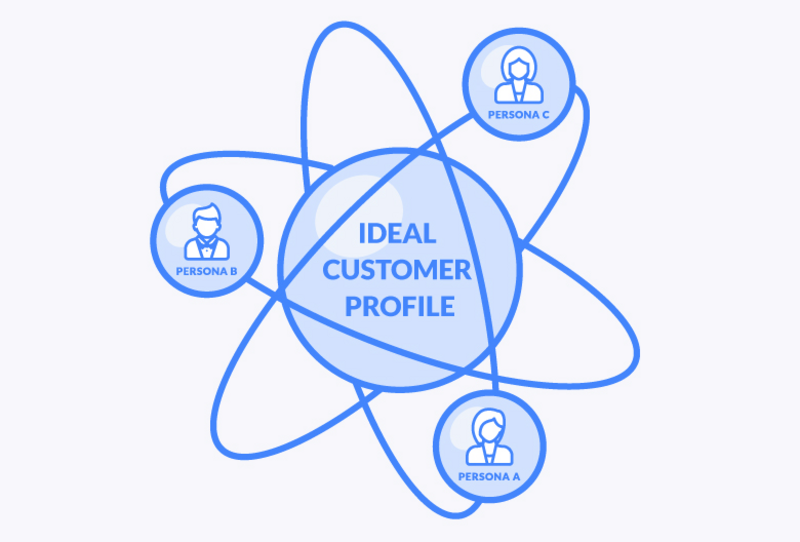
Source: propellercrm.com
User
One of the buyer personas is the user who ultimately uses the product or service. This user group is also usually the person who is actively looking for a solution to a known problem in order to eliminate pain points and move the company forward, which becomes particularly relevant for content marketing.
Since the user persona is usually the first contact with the company, the following messages should be conveyed as much as possible to address it in the best possible way:
- The offer makes the user persona's job easier/more productive/more relaxed/ ...
- The user persona can develop personally through the offer, such as learning something new, improving a skill or being promoted
- The user persona is convinced of the company's expert status by the website
- Solving the problem through the offered service or product makes the user persona something special
The user persona usually has the greatest share of practical experience and therefore needs to be convinced that your solution addresses a real need and creates added value.
Decision maker
In the B2B sector, the decision-maker persona is the most important persona that needs to be convinced: after all, they are the ones who become the sponsor of your offer and perform the persuasion work within your company that the offer should be purchased.
At the same time, they also have to uphold the interests of the company, especially from a financial point of view. Therefore, the ROI is decisive for the decision-maker person and should therefore appear in your website content in whatever form.
Examples of elements that are particularly relevant for the decision-maker persona:
- ROI calculator
- RFT templates
- Buyer’s guides
The decision-maker persona acts as a kind of mediator and is not only responsible for "selling" the offer to their own team but also to the management level. They decide on the budget or other stakeholders, such as the IT or legal departments.
Blocker
Even though the decision-maker persona is usually also the buyer, the blocker persona must also be convinced of the purchase. They are often members of the management level who attach particular importance to ROI, risk minimization, the preservation of company values and resources, and legal framework conditions. Thus, this persona, as the name already suggests, can block these purchasing decisions.
Blocker personas often have limited technical knowledge and are willing to learn more but have difficulty making decisions. Therefore, they need concrete information and application examples to better understand the context of the offer and make the best decision based on this.
Overall, the goal of your B2B website should be to address all these buyer personas. Even though the decision-maker persona is the decisive force that decides for or against a purchase, the concerns of the user and blocker persona should also be addressed.
It is also important to mention that your ICPs should not be used decisively to accept or reject new business opportunities at all costs: There are often also companies that are not covered by your ICPs but are nevertheless a good fit for your products. Thus, ICPs have the main task of giving you the framework for which companies to proactively address by investing in sales and marketing.
The difficulty here: All these personas have different interests and pain points - users want to simplify the task, while CEOs have the budget in mind - which is why a well thought out approach is necessary here. You can control this through specific content and elements on your B2B website.
What content and elements should a B2B website include?
For practice, of course, the most important question is: What should a B2B website look like concretely? Here you'll find our most important tips on what a good B2B website should definitely illustrate in order to achieve the desired goals.
Sensible subpages for B2B company websites
Sounds logical, but is often underestimated: If you work with companies, your website should also be designed for companies! That is: it needs Landing Pages for the individual target group segments that we introduced above, so you can address them even more specifically.
This includes application cases: with them, you can show which industries the B2B solution can be used for. Examples are always helpful to give your target group a better idea of how the solution can be applied.
Similarly, case studies. These give your target group an overview of how your offer can be implemented in practice. But they also serve to build trust and prove that you can achieve real results with your solution! We recommend using case studies wherever possible, especially those that underline the possible applications of your offer.
Contact pages are also extremely important on B2B websites: only through them can your customers contact you and obtain information about your offers. So it is important that the contact information on these pages is always up-to-date and complete, to keep the bounce rate, i.e. the drop-off rate, as low as possible.
An alternative to contact pages are demo or appointment booking pages, which are commonly used in B2B. Here, users can book a consulting appointment or first conversation with a sales representative directly. Practical implementation can be achieved by embedding corresponding solutions from Calendly or HubSpot Marketing Hub.
Understand your target group(s)
One of the most important aspects: Know your target group(s) inside and out! Because they are the ones who ultimately buy your products or use your services. What many forget: The website should also be 100% oriented to the needs of the target group.
Therefore, continuously inform yourself about new trends or problems that occur with your ICPs and address them specifically on your website. Your sales teams, your customers directly or also competitor analyses, from which you derive what customers find particularly positive or negative about your competitors, provide information.
Benefit instead of features
You probably also know these websites that bombard customers with features of their products: “With practical hanger”, “handmade”, “without preservatives” or “battery life of over 40h”. All this information may be relevant to the users in their purchasing decision, but they are not sufficient to convince them.
It is therefore more effective to communicate the benefit of your product or service, instead of only their features. What counts is what the users “get from it”, i.e., which benefits arise for them. So, from your benefit quickly becomes a value for the customers, for example, “the battery life of over 40h allows you to stream your favorite series without interruption – even on the go”.
Your target group feels more directly addressed because with the benefit you are also addressing underlying pain points that your product or service solves.
Trust, Trust, Trust
What is more deterrent to customers than a website that only talks about features? – A website that does not look trustworthy! Therefore, trust elements should be a central part of your website.
Trust can be created in different ways: Through concrete numbers and facts that underline your work, awards, quality seals, customer reviews and testimonials are just a few examples. To use these trust elements as effectively as possible, we recommend that you distribute these elements on your website to continuously win the trust of your users.
Cases – Show the implementation and use of your offer
When you present your product or service on your website, your users often cannot yet clearly imagine how the implementation can look concretely. You can easily remedy this by making case studies a part of your website!
Case studies give your users insights and ideas on what your solution can achieve based on concrete examples. With this, you show them different areas of application of your offer and what it can look like after implementation. This makes it easier for your users to better imagine the final results and builds trust in your offer.
Create added value with educational content
Whether it's a company blog, glossary or webinar: Educational content take your website to the next level! With these contents, you not only create an expert status, which in turn creates trust, you also create significant added value for your users.
Your users can learn something from your content and possibly even eliminate their own pain points. This creates an optimal basis for a later business relationship, as your users can already experience for themselves that your offer works. If this content is also SEO-optimized, it creates additional traffic, through which you can be found.
Functioning tracking
Website tracking refers to the collection of data about the behavior of users on a website, such as clicks, page views, dwell time or engagement. This is implemented through tracking methods such as cookies & pixels and Web Analytic Tools.
In the B2B area, website tracking is extremely relevant, as companies often offer high-priced products or services and thus have more complex sales funnels than in the B2C context, for example. By tracking the behavior of users on a website, companies can gain valuable insights into the interest and intentions of potential customers. For example, they can determine which pages are visited most frequently or which products or services are in greatest demand.
These insights can help companies improve their marketing and sales strategies by creating more targeted content and offers and optimizing their lead generation and conversions. In addition, companies can identify potential problems on their website through website tracking, such as non-functioning pages, and quickly fix them.
Test everything
A website, whether B2B or B2C, should be considered a work in progress and should always evolve: Both the market, your company, and your ICPs are dynamic and continue to evolve, which should also be reflected on the website.
With new insights and learnings, you get the opportunity to continuously improve your website and adapt it to new developments and ICPs. To implement this as efficiently as possible, every change on a B2B website should be made data-based and tested.
This is where Web Analytics Tools come into play: Tools like Hotjar or Google Analytics allow you to analyze exactly how your users interact with your website. KPIs such as bounce rate, dwell time or conversion rate can then be used to optimize the website.
Whether these changes bring a measurable improvement can then again be checked statistically with A/B Testing Tools. These tests give you valuable insights based on real data, how your website with its individual elements should be built in order to function best.
How should a B2B website be built?
To make the construction of your B2B website as simple as possible, here are our tips:
Reliable, stable host
First, choose a website host, that covers your needs and allows you to work in a scalable way, and ensure short loading times with Web Acceleration Software.
Form follows Function
The alpha and omega principle when it comes to design: your website design should be laid out in such a way that it conforms to its function and purpose and supports and presents their functions and contents in the best possible way.
Work with Mockups
Before building, it makes sense to design a mockup - this is relevant both if it is to be implemented by developers later and also because you can work more creatively in Web Design Tools like Figma
than in Website Builder Tools
.
Scalable
Your website should be built to be scalable, so it can grow with your company. Ideally, your marketing team can also adjust it.
Component-based DesignThe website design
should be based on individual components, to quickly and easily design and implement new landing pages.
Use No-Code ToolsWhen building your website, we recommend using no-code builder tools like Webflow or WordPress. In addition to the easy creation of websites, it is also important that the CMS
is easy to use for each user.
Successful B2B Websites – What does a good website look like?
So what does a good B2B website actually look like? Here are our learnings on how it works best:
Exemplary structure of a working B2B websiteThe structure of a B2B website
can be very different: it strongly depends on your target group and your company itself and is always individual.
- For this, we also like to apply different copywriter formulas that work better with certain target groups, for example:
- The copywriter formula BAB ("Before-After-Bridge") first discusses the state before the solution. Then the one after the problem is solved, and finally the solution itself. This formula works particularly well with problem-centered target groups.
The 4P formula (“Promise-Picture-Proof-Pitch”), on the other hand, first presents your claim about your offer, followed by a pictorial description, the proofs of effectiveness, and a pitch in which you present the solution. This works best with solution-oriented target groups.To give you a general idea of how a B2B website should basically be structured, we have created a proven template
that you can use as a guideline:
Remember: This template should only be considered as inspiration and adapted to the individual needs of your target group and your company!
Top 3 examples of best cases – Company website examples
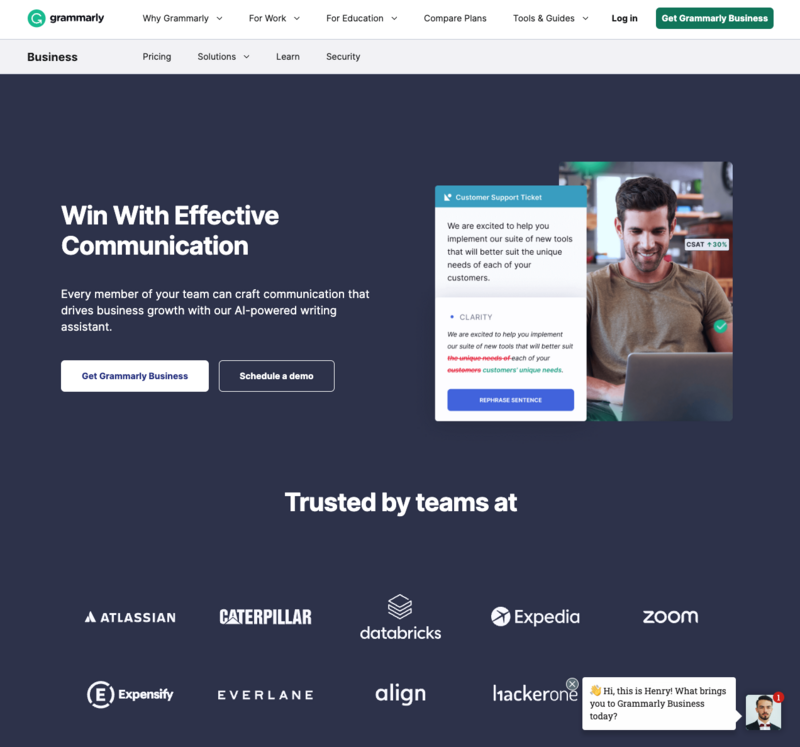
1. Grammarly
Source: Grammarly
- On Grammarly's B2B website, it is immediately clear what benefit users get from the product: convincing with effective communication. This is sustainably underlined with the graphic of an application example. The logos of customers create a strong trust effect.
- Hero graphic effectively and simply shows how the tool works and what benefit it has
- Strong benefit & feature communication based on the FAB formula
- Risk reduction through clarification about GDPR & security features
Offer various benefits for different user personas (Support, Sales, Marketing)
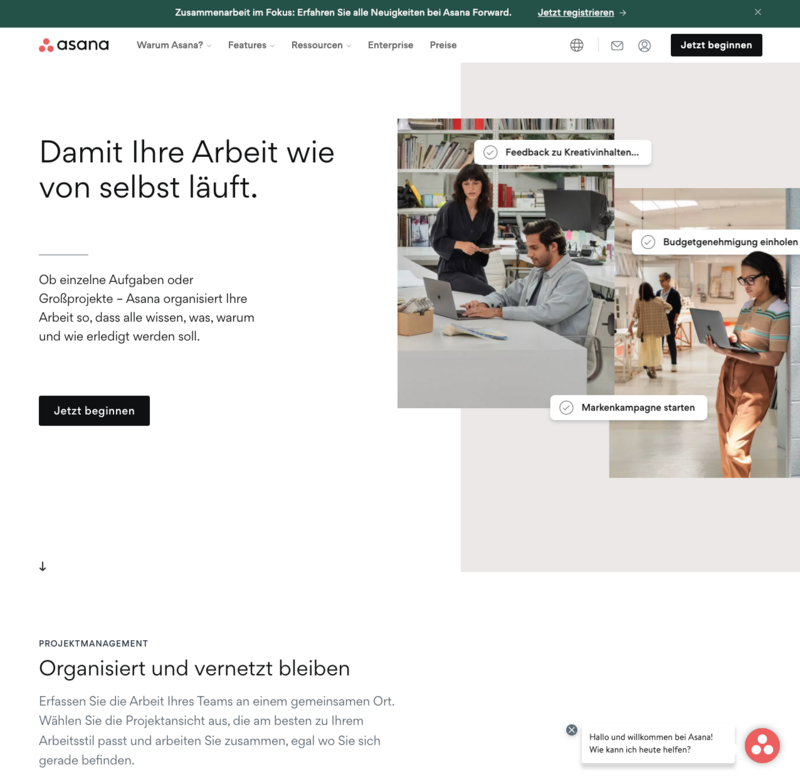
2. Asana
Source: AsanaAsanaAlso at
- the benefit for its users is directly recognizable and at the same time shows the most important functions of the software directly in the hero section.
- Integrations are not only represented by logos, but use cases are shown
- Individual use cases are described using interactive graphics
Inclusion of high-quality produced testimonial videos
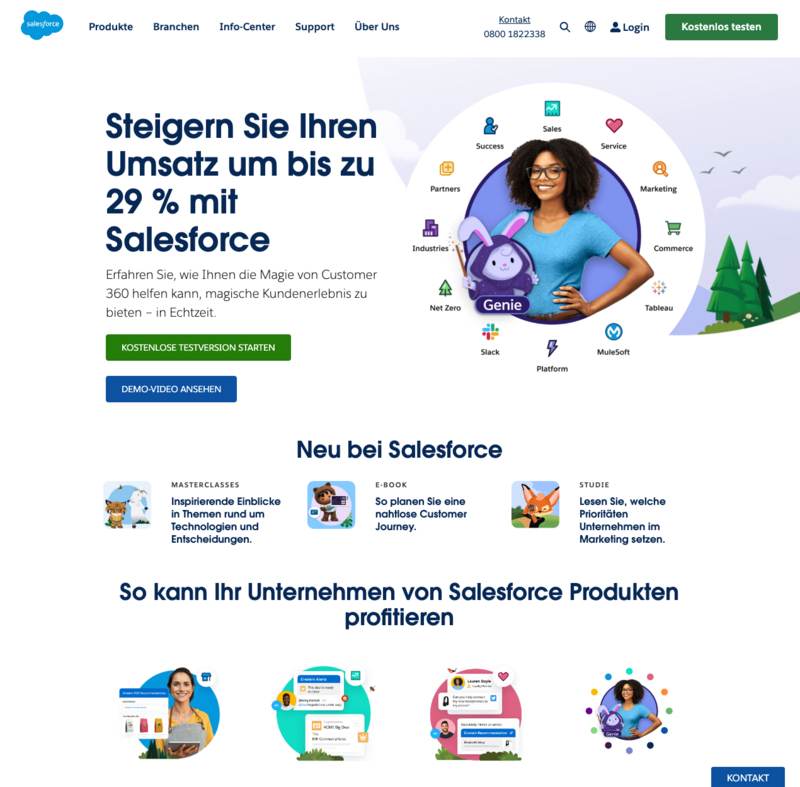
3. Salesforce
Source: Salesforce
- The website of Salesforce convinces not only with the focus on the benefit for customers and real numbers, but also directly alerts website visitors to their educational content. This conveys trust, which Salesforce has built up through the expert status.
- Smart CTA naming through a Call to Value
- Benefit communication through the use of the FAB formula
- In the last CTA, a 100% risk-free trial is offered to provide users with a weaker CTA goal
No distraction by removing the navigation bar
Conclusion




